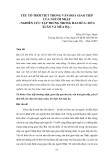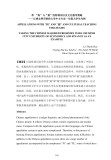
Tạp chí Khoa học Ngôn ngữ và Văn hóa ISSN 2525-2674 Tập 8, số 1, 2024
10
CULTURAL METAPHORS IN AMERICAN ENGLISH
AND VIETNAMESE SHOP SIGNS
Pham Ngoc Truong Linh
VNU Ho Chi Minh City University of Social Sciences and Humanities
truonglinhpham101@gmail.com
(Received: 15/12/2023; Revised: 31/01/2024; Accepted: 22/02/2024)
Abstract: Shop signs play an important role in the time of global trade and tourism. Previous
studies have reached general conclusions about the characteristics, expressions, and functions
of shop sign language. This study aims to explore the cultural, pragmatic, and social concepts
encoded in shop sign language through cultural metaphors. The data was collected and
observed from American and Vietnamese contexts respectively. The cultural
conceptualizations embedded in the linguistic expressions are discovered by metadiscourse
analysis and then generalized in the form of cognitive (metonymy) models that underpin the
understanding of the cultural metaphors. The results show significant differences between
the two speech communities in cultural metaphors related to customers, business scale,
business identity, product origin, relationship, and quality. The study contributes specific
theoretical and practical insights into English and Vietnamese shop signs from the
perspective of cultural cognition, thus providing a base for analyzing coding phenomena at
the level of cultural conceptualization contact and intercultural pragmatics.
Keywords: Cultural cognition, cultural conceptualization, cultural metaphor, American
English-Vietnamese contrastive analysis, shop sign
1. Introduction
In the process of globalization, there has been an increasing number of international
visitors in Vietnam's tourist areas and commercial centers. The shop sign language has always
been subject to cultural contact with constant changes in code switching or code mixing to allow
for the accessibility of different speech communities around the world. Many studies on shop
signs from the perspective of social linguistics and contact linguistics rely on these aspects to
assess the level of indigenous cultural preservation and the degree of cultural integration in a
geographic area (e.g. Akindele, 2011; Thongtong, 2016; Zimny, 2017; Phan & Starks, 2019).
However, cultural contact in shop sign language should not only lie in the semiotics but
also in the interaction and reconstruction of cultural conceptualizations that take place in speech
communities’ perception. This type of interaction belongs to what cultural linguistics calls
“cultural cognition,” a form of systematically interactive cognition between individuals and the
community that underpins understanding of linguistic characteristics as experiences to be shared,
applied, and reconstructed.
When it comes to studying language from the cognitive approach, the conceptual analysis
of metaphorical models cannot be ignored. Metaphors from the perspective of cultural linguistics
are called “cultural metaphors.” They are derived from and based on traditional metaphors and
conceptual metaphors while having their own approaches and methods of analysis towards the
dialectical relationship between the components and the whole cognition of a speech community.

Tạp chí Khoa học Ngôn ngữ và Văn hóa ISSN 2525-2674 Tập 8, số 1, 2024
11
This study aims to investigate the cultural conceptualizations encoded in (American)
English and Vietnamese shop signs through cultural metaphors, thereby contributing a
methodology for specific analysis of cultural expressions and contacts between the two languages
on the level of cultural cognition. The research questions include:
(1) What are the cultural metaphors entrenched in the language use of English and
Vietnamese shop signs?
(2) What are the cultural cognitive models that explain the cultural conceptualizations
underlying such cultural metaphors?
(3) What are the cultural metaphor variations between the two speech communities?
2. Literature Review
2.1 Cultural cognition
According to Frank (2015, p. 494), cultural cognition is a multidisciplinary concept that
involves the type of perception beyond human awareness, that is, existing objectively, naturally,
and dynamically in the interactive world where humans are the main subject that both influence
and at the same time are influenced by the cultural cognition in thinking, behavior, and language.
On the theoretical basis of cognitive science, Sharifian (2017, pp. 3-5) formulate the
concept of cultural cognition with the properties of being enactive, unevenly distributed, and
dynamic. In other words, cultural cognition of a speech community is formed by the process of
human’s linguistic and social interaction through space and time; almost never shared equally
among the members; and can be agreed upon or re-agreed upon through generations and
interaction with other speech communities. Sharifian (2017, pp. 4-5) explains that cultural
cognition can act as a CAS (a complex adaptive system) with emergent, nested, and open
properties, corresponding to the characteristics of cultural cognition in the relationship between a
speech community and its members.
In addition, Sharifian (2017) and previously Goodenough (1957) both emphasize the key
influential role of member components in developing, distributing, and strengthening cultural
cognition; and at the same time, a member’s language use is influenced and shaped to varying
degrees by the cultural cognition of that speech community. However, it should be noted that the
general manifestations of the whole system are not the sum of the manifestations from member
entities, nor are the manifestations of each member entity representative of the whole system.
Frank (2015, p. 497) argues that the study of cultural cognition as such type of “distributed
cognition” has opened opportunities for effective exchange between scholars in the humanities
and subdisciplines of cognitive science.
In short, the concept of “cultural cognition” is constructed based on the theoretical
foundations of many other fields, such as cognitive psychology, complexity science, distributed
cognition, and anthropology.
2.2 Cultural conceptualizations
Conceptualization is the process of conceptual formation. A “concept” is generally
thought to be the unit of human consciousness, reflecting not only the basic properties and
relationships of things and phenomena in objective reality (i.e. definitions) but also the subjective
human perception of those objects (Langacker, 1987; Ly, 2008; Tran, 2011; Nguyen, 2015). The

Tạp chí Khoa học Ngôn ngữ và Văn hóa ISSN 2525-2674 Tập 8, số 1, 2024
12
scholars argue that a “concept” is both universal (reflecting the objective world) and specific
(relating to the cultural and linguistic characteristics of a speech community). Langacker (1987)
advocates that the formation of a concept requires a contextual background called a “domain” or
a “cognitive field” on which certain features of things and phenomena become “focuses” for the
concepts to be separated and formed. Thus, conceptualization and its products (concepts) are
constantly changing between different cognitive fields and different attention stimuli of different
communities, eventually encoded in different linguistic systems.
Conceptualization is intrinsically cultural, forming cultural concepts and is therefore
called “cultural conceptualization.” The culturalism of cultural conceptualizations manifests itself
in the fact that the focus of attention to objective things is shared and passed on among members
of a speech community. These focuses are also the result of the whole community’s selection
among a wide range of attention focuses belonging to the perception of its members as well as
other stimuli across space and time. Thus, it can be said that cultural conceptualizations
themselves are also products of cultural cognition with enactive, distributed, and dynamic
characteristics. Sharifian (2011, 2015, 2017) asserts that many aspects of language structure and
language usage entrench and reflect cultural conceptualizations; but language is simultaneously
an environment in which cultural cognition is structured and restructured through human
linguistic and social interaction, thereby creating the development of cultural conceptualizations.
2.3 Cultural metaphors
According to the traditional view from the time of Aristotle (384-322 BC), metaphor is
considered the main mode of enlarging vocabulary based on the similarities between things and
phenomena and is the basis for rhetorical, synonymous, and polysemantic means. Therefore, it
can be said that metaphor is a typical characteristic of language. On the other hand, metaphor is
also a mode of conceptualization. The linguistic expressions of metaphors that differ between
speech communities represent the divergence of different systems of cultural conceptualization.
However, the tool for approaching and analyzing (cultural) conceptualizations is only fully
developed at the stage of “conceptual metaphor” with “mappings,” which present a form of
conceptualization that describes or understands a target domain through a source domain (Lakoff
& Johnson, 1980; Lakoff & Turner, 1989).
From the perspective of cultural linguistics, an individual’s cognition within a community
is influential and contributing, but not entirely reflective of the cognition of that community. For
example, the conceptual metaphors within the scope of an author’s works reflect only part of the
cultural cognition of the speech community in which he is a member while simultaneously
contributing to it. Thus, Sharifian (2017) uses the term “cultural metaphor” for the metaphors
constructed in the interaction between members of a community across space and time, in the
same way that parts or entities influence and are influenced by the general characteristics of a
system in the form of a CAS (complex adaptive system).
Sharifian (2017) advocates that cultural metaphors are essentially conceptual metaphors
derived from community elements; built and shared among members in the form of traditional
experiences and cultures such as history, religion, beliefs, folktales, etc. For instance, TRỜI ĐƯỢC
XEM LÀ CÔNG ĐẠO ‘sky as justice’ is a common cultural metaphor in Vietnamese, as expressed in
Trời sẽ không tha người bất nghĩa ‘the sky will not spare unrighteous people;’ Ăn ở ác coi chừng
trời đánh ‘those living evilly watch out for sky lightning;’ Ông trời có mắt ‘Mr. Sky has eyes.’

Tạp chí Khoa học Ngôn ngữ và Văn hóa ISSN 2525-2674 Tập 8, số 1, 2024
13
Sharifian (2017, p. 18) argues that the conceptual metaphors of later generations also often have
deep cultural manifestations, and that recent studies on conceptual metaphor theory are more
culturally relevant than previous ones. It is obvious that that many cognitive linguists studying
conceptual metaphor theory have been shifting to approaches of cultural linguistics.
However, between conceptual metaphors and cultural metaphors there is a slight
difference in perception paradigm. Conceptual metaphors focus on the nature of mechanical and
local transitions from one conceptual domain to another through mappings. When conceptual
metaphorical models are established, activated, and applied, it is the movement of the subject
itself as a whole. Meanwhile, cultural metaphors focus on the nature of sharing and transferring
(i.e. distributed cognition); conceptual domains are understood through each other by the
experience and pre-existing common knowledge of the speech community that Wa Thiong'o
(1986) and scholars of cultural linguistics call the “collective memory bank.” Thus, cultural
metaphorical models are less considered in terms of equivalent conceptual transformation but are
often described by a sequence of objective cognitive processes that affect the attention focus of
conceptualizations. Accordingly, instead of using “is” (emphasizing the cognitive equivalence)
for cognitive models as in conceptual metaphor theory (e.g. THE HEART IS THE RULER OF THE
BODY), Sharifian (2017) suggested using “as” (emphasizing the cognitive influence and
distribution) in standard cultural metaphor model for cultural linguistics (e.g. THE HEART AS THE
RULER OF THE BODY).
3. Methodology
The study aims to explore similarities and differences in cultural cognition (cultural
conceptualization) associated with the cultural metaphors in English and Vietnamese shop signs.
Therefore, it utilizes qualitative methods such as analysis, synthesis, reference, theory
construction based on shop sign language data as well as other related cultural, social, historical,
and psychological evidence.
3.1 Research subjects and scopes
The subject of the study is shop sign language in written form visibly presented outside
a business facility. These subjects are examined within the scope of the pragmatic cultural schema
of ‘advertising’ as a foundation of understanding for specific speech acts/events associated with
cultural categories or pragmemes that are specifically expressed by pragmatic acts, including
certain linguistic expressions encoding some cultural metaphors (Table 1).
Table 1. Components of the pragmatic cultural schema of ‘advertising’
Pragmatic cultural schema of ADVERTISING
Speech acts/events
emphasizing
the focus of
the business
describing the
scale of the
business
emphasizing
the identity of
the business
ensuring the
reliability of
quality
expressing
credibility
showing
outstanding
qualities
Cultural categories as Pragmemes
CUSTOMER
SCALE
IDENTITY
ORIGIN
RELATIONSHIP
QUALITY
Linguistic expressions as Pragmatic acts
[gender, job,
class]
[small/medium,
large]
[brand name]
[domestic,
foreign]
[kinship,
friend, love]
[healthy,
affordable]
Cultural metaphors

Tạp chí Khoa học Ngôn ngữ và Văn hóa ISSN 2525-2674 Tập 8, số 1, 2024
14
The components of the pragmatic cultural schema of ‘advertising’ mentioned above are
universally potential in shop sign language (Kathpalia, 1992; Bhatia, 2005; Pham, 2021); yet
some variation might be observed due to the divergence in the system of cultural
conceptualizations between different speech communities.
3.2 Data collection
With the help of the Street View tool on Google Maps, images of English and Vietnamese
shop signs were observed from various US states and major cities of Vietnam (mostly in Ho Chi
Minh City and Hanoi). In addition, the shop sign language was also collected from shared images
on google.com, alamy.com, yelp.com, and from images taken by our phones. The observed
subjects were recorded by Google Maps volunteers and the websites over the years between 2013
and 2023. The final data include 1,748 (American) English and 1,585 Vietnamese shop signs.
3.3 Data analysis
Metadiscourse analysis was used to discover and evaluate the cultural conceptualizations
encoded in some special or repeated language units called “linguistic markers.” Sharifian (2017,
p. 45) argues that these markers are a combination of (i) associated community experiences in
terms of meaning and usage, (ii) meaning and function in specific communication contexts, and
(iii) the relationship between perceiving and evaluating meanings as a conceptualization.
Based on the identified conceptualizations, several cultural metaphors were presented and
analyzed using cognitive models, especially those of “cognitive metonymy.” Lakoff & Johnson
(1980), Kövecses & Radden (1998), and Barcelona (2003) contend that cognitive metonymy acts
as “motivation” or conceptualized form of metaphor as well as cultural metaphor, and cognitive
metonymy also diverges between different speech communities (i.e. systems of cultural
conceptualization), reflecting different widely accepted cognitive principles (i.e. cultural
cognition). Some of the basic models of cognitive metonymy underlying the analysis of
metaphorical models are based on the interchange between concepts such as WHOLE and PART,
CATEGORY and PROPERTY, HUMAN and NON-HUMAN, CONCRETE and ABSTRACT, INTERACTIVE
and NON-INTERACTIVE, MORE and LESS, IDEAL and NON-IDEAL, etc. (Kövecses & Radden, 1998).
Each general expression from the description of the English cultural metaphors was
compared with possible equivalent expressions in Vietnamese to detect some similarities and
differences in the way things and phenomena of the same type are perceived and conceptualized
between the two languages. In addition, cultural concepts associated with the cultural metaphors
were systematized from many other reference sources in cultural, historical, psychological, and
social perspectives. While similarities are seen as supportive points in intercultural
communication, differences are seen as things to be learned and given special attention (Lado,
1957; Gass & Selinker, 2008).
4. Findings and Discussion
4.1 Cultural metaphors relating to ‘customers’
4.1.1 Cultural metaphors relating to ‘gender’
In Vietnamese shop signs, nam nữ ‘male-female’ is often used to indicate the entire
general customers (e.g. Thời trang nam nữ ‘male-female fashion;’ Tạo mẫu tóc nam nữ ‘male-
female hairstyling’). This cultural metaphor originates from Vietnamese expressions with pairs














![Đề cương Văn học phương Đông [chuẩn nhất]](https://cdn.tailieu.vn/images/document/thumbnail/2025/20251213/quynhanhtranthi1209@gmail.com/135x160/52041765594608.jpg)











